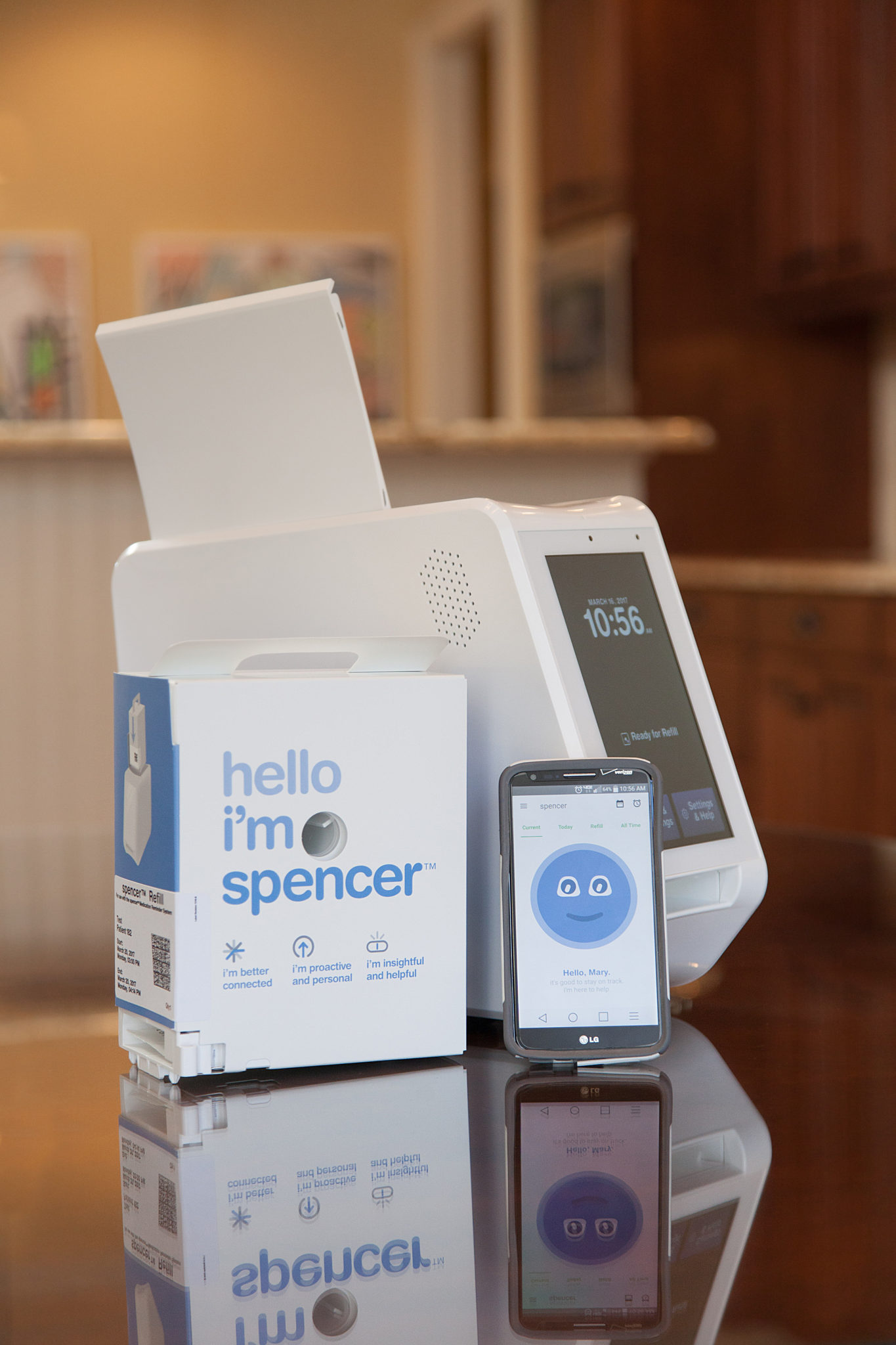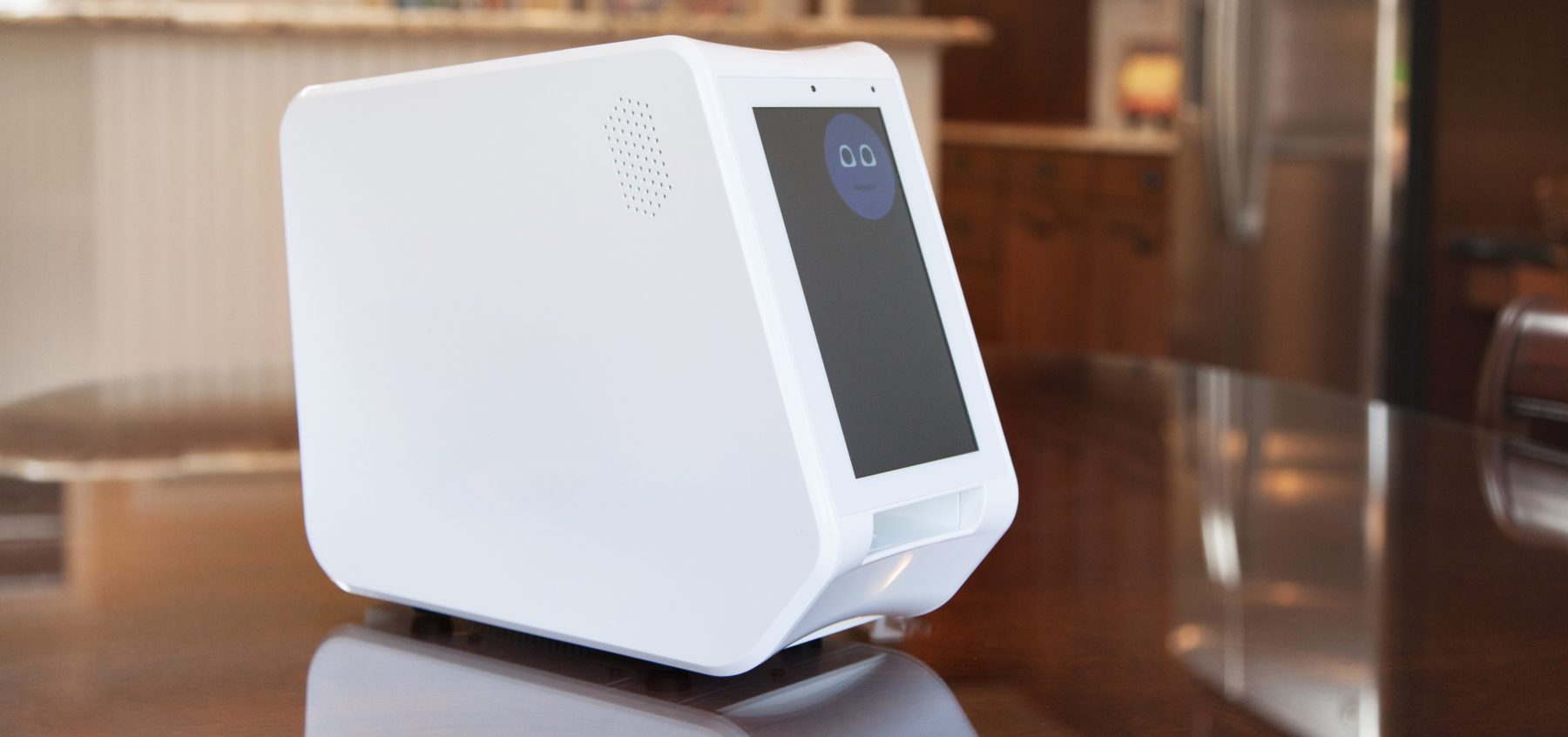HAP Innovations has a simple mission: To make it easier for people to live healthy and independent lives. Currently, their focus is on older patients, suffering from chronic conditions, who must take multiple medications a day. While a slew of solutions exist to help these patients remember to take their medications, HAP Innovations CEO, Tom Rhoads, felt few of those solutions really addressed the problem. Enter spencer®.
spencer is an FDA-registered health hub, that includes a countertop in-home medication dispensing and engagement device, the spencerAssist™ mobile app for family caregivers, and the spencerCare™ clinical site for pharmacists and care providers. What makes this solution especially unique: A national network of pharmacists specializing in the treatment of patients with multiple chronic conditions monitor patient input using the spencerCare™ clinical portal. But not only does that enable personalized health coaching, the dispenser itself also offers a humanized approach through the spencer emoji that offers several faces to offer patients support and let them know that someone cares whether they take their medications.
The company recently announced the results of an early pilot program for spencer that showed a 90% rate in taking medication as directed. That is in addition to achieving 60% to 80% engagement rates via the spencer platform. PM360 spoke to Rhoads about why he helped to create spencer, what makes it different from other available adherence solutions, and how pharma companies can benefit beyond better adherence.
 PM360: How did you come up with the idea for spencer?
PM360: How did you come up with the idea for spencer?
Tom Rhoads: It was 2:00 a.m. and I just got my dad in the emergency room at the hospital. The doctor asked, “What medications is he taking?” Having been an executive in the pharma industry for 12 plus years, you would have thought that I’d have the answer to that. [Laughs] But I didn’t. So, I ran home, grabbed all his vials, and realized just how complex medication adherence can be. That was a long night, for sure, but my dad’s doing fine. And, it allowed us to see a market that was in search of higher quality standards and better outcomes that allow people to live with dignity in their homes longer—and ideally healthier. That began the journey, as after that we started talking to pharmacies, providers, payers, pharma, etc., to really understand how to address the issue.
We found that a lot of people come at it in a pretty fragmented perspective. They offer just med management or med reminders. Or they have apps that might do conditional-related feedback. They might also have peripheral devices and wearables that need battery charging. But collectively, they weren’t able to address the problem, largely because they weren’t aggregated. Our strategy became: Converge the technologies into a very elegant, home-based health hub and system that would allow people to manage one of the more complex aspects of their care—their meds. But also, connect back to the healthcare team. Our model is also very unique in that we have pharmacist partners that specialize in polychronic patients (people with multiple conditions).
I think Dr. Madison from Kaiser said it best, “There’s a lot of snake oil out there.” Most current solutions are really disconnected, unless they have a provider overseeing them. And, the vast majority doesn’t. In our system, the pharmacist is always monitoring the patient, and then we can also pull in other members of the care team, such as the family.
How does the automated, in-home pill dispenser work in terms of loading the meds? Is that something pharmacist must do, or can the patient and/or care team handle that?
Our demographic is typically someone that’s on five or more medications per day, and in most cases, has at least two chronic conditions. So, under our model we align them with high-performing pharmacies that we certify. This both ensures the quality of the system and the engagement that we require, but also shows the payers in the accountable care organizations that we’re working with that we have a very high-performing network.
Additionally, the pharmacies we work with specialize in the care of someone with multiple conditions and lots of medications, and have agreed to also monitor those patients through the system. So, step one is identifying a high-performing pharmacy and aggregating all of a patient’s scripts to that pharmacy. Step two is a system that’s simple to use.
For example, my dad—who I beat up in many interviews and conversations over the years, but is terrific person—is prototypical patient for spencer. He has eight chronic medications and technology is something he’s open to adopting, but he is not exactly a textbook technology geek. That is why the system must be simple and able for patients to manage themselves. In the case of my dad, he’s got severe arthritis, so we also took that into account.
He struggles with opening 12 different vials of medications that he takes across his regimens as well as some supplements. But in our system, it comes to him in a simple, little container we call “spencer refill,” that the pharmacy will send him. All he has to do is drop it right into the spencer.
Finally, step three is making sure the interactions with any of our customers is largely passive, but at the same time very engaging. And that’s the most exciting thing about a lot of the results we’re seeing. We’re asking two questions a day of the population using spencer, and we’re getting anywhere from 60% to more recently 80% answer rates on those questions. It’s really an unprecedented step forward to true home engagement.
 What kind of questions are you asking and what do you refer to when you say engagement?
What kind of questions are you asking and what do you refer to when you say engagement?
Engagement for us is whether the patient is responding to questions asked by the pharmacist, doctor, payer, etc. For instance, through spencer, a healthcare professional can ask the patient, “Can we have a doctor’s appointment tomorrow?”, “Are you able to come?”, and, “Do you need a ride?”
Often, we hear the ability to engage patients in this demographic—whether through phone or other outreach—is very difficult. In one example we saw, on average, providers are calling their patients almost nine times, and after that ninth time they still only have around 30% of the total population answering their questions. But with spencer, we are driving 60% to 80% answer rates.
Furthermore, beyond those basic questions, the pharmacist and/or provider can ask any custom questions directly through the system to the patient. They can also set up standard questions based on disease type. For instance, you can set up a series of questions you would wish to ask your diabetic patients over the course of the month. And then use that as a baseline in a risk assessment. That gives better information back to the pharmacy and the doctor as far as their level of care.
The spencer is also compatible with peripherals, and questions can be paired with their use. For example, “We haven’t seen a blood pressure reading in a couple of weeks. Would you mind taking your blood pressure for us?” The system will automatically connect through Bluetooth to the blood pressure cuff and capture that information.
Does this work both ways? Can a patient ask a question to their pharmacist or doctor through spencer?
We’re actually adding a couple of different aspects to the spencer platform that will allow for that, as well as on spencerAssist™, which is our mobile platform. The caregiver will also have the ability to make some modifications, and to ask questions or have the pharmacist clarify some of the information they might be looking at. We’re also connected to the provider, so the idea is that it can become a home health hub and allow for rich engagement between the patients and their care team.
In terms of being a whole hub, and not just an in-home dispenser, what other unique features does spencer offer?
The platform is very robust, and includes a full telehealth application within it. Once again, that allows some of these partners (pharmacist, provider, payer, caregiver, etc.) to directly interface with the patient through the spencer platform via a two-way video chat. The system also allows them to schedule appointments. All of this is key because only about 40% of this demographic uses a smartphone, so a lot of the applications that are out there that can do similar functions are not being used by these patients. But, this allows for those kind of engagement opportunities directly through spencer.
Another interesting feature is we can allow for socialization—where they permit that. So, spencer can be used to keep them engaged with occasional jokes, or just a warm and friendly presence.
The other big avenue is that we work closely with the pharmacies and their management systems, so we’re able to see all of the different medications someone’s taking. So, we can see the changes that are made to those medications, and if there’s a change to a medication or a pill just changes in shape or color, we can actually show the patient those changes during the dispense. That is very important because almost 15% of the population will stop taking a pill because they don’t recognize it, according to several studies. And this population has almost two changes a month on average.
How do patients gain access to spencer? Recently, you announced that you only have spencer-certified pharmacists in 32 states. Can patients only gain access to spencer if they live in one of those states?
The simple answer: Yes, if you live in any of the 32 states, and you have access to a spencer-certified pharmacy, you could get spencer for yourself or for your loved one. Additionally, we do hope to expand to all 50 states by the end of the summer. However, our focus on the market is primarily through partnerships and not individual sales. We are working with health systems, accountable care organizations, the government, and integrated delivery networks. Additionally, some of the payer pilots we’re doing are primarily focused on the Medicare Advantage marketplace.
We try to maintain a relatively tight focus through our partnerships, and in those situation, patients will be targeted by our partner groups and be invited to join the system and gain access to spencer. We’ve also had a lot of interest through some of our pharmacy partners to bring on more local patient populations that might not be aligned with one of those systems or Medicare Advantage plans yet. In those cases, they can purchase spencer through our website, www.helloimspencer.com, and we will align them with the available pharmacy supporting spencer in their area.
Sticking with partnerships, are you interested in partnering with pharma companies who want to help increase adherence rates of their medications?
We are. In fact, some of my earliest conversations were with pharma. Out of the gate, they were looking at specialty medications, and then they came back and started looking at clinical trials. We have an opportunity to participate in a clinical trial later on in early Q1, and we are also looking at just the engagement aspect (i.e., being able to do post-market surveillance). So, we definitely believe spencer can help augment pharma’s ability to see how their medications are doing out there and gain almost instant feedback from the population taking those medications or those that are being targeted for their medications.
Finally, what is next for spencer?
We plan to add more verbal responsiveness to the system similar to an Alexa. That way questions from your provider team can be asked by spencer—even though they’re text on the screen—and verbal answers can also be digitized and captured so that we can have a more fluid and natural engagement from our consumers. We’re also working on some other exciting aspects to continue to drive a deeper and richer content and engagement with the people at home.






